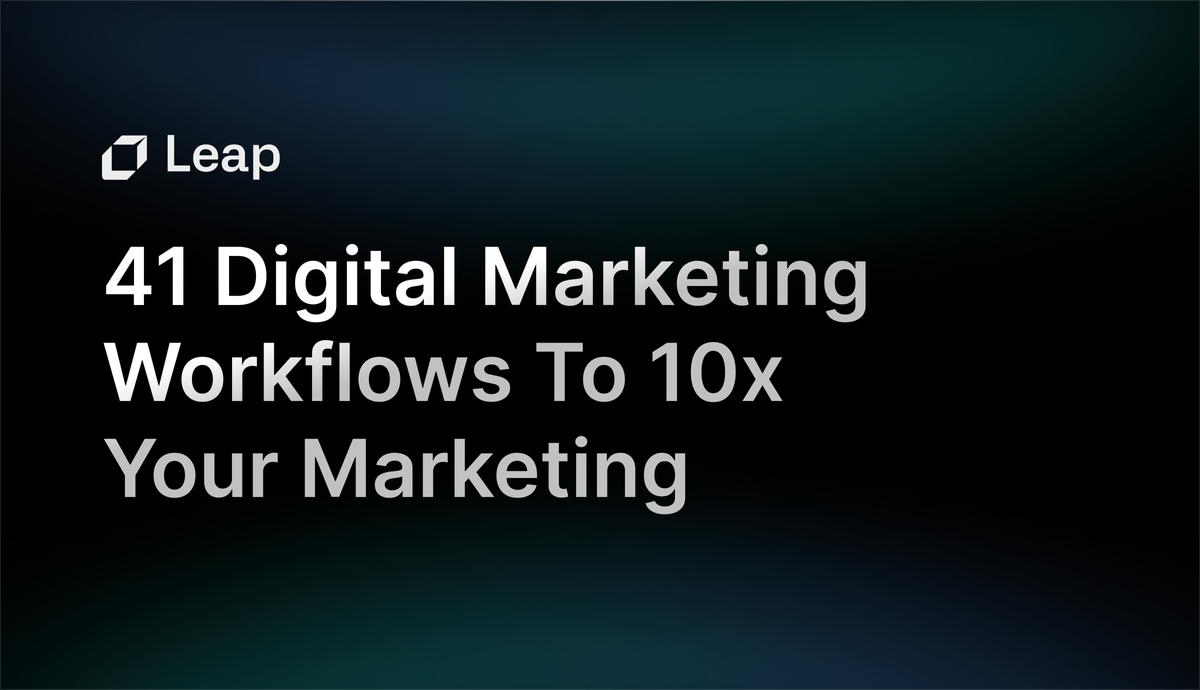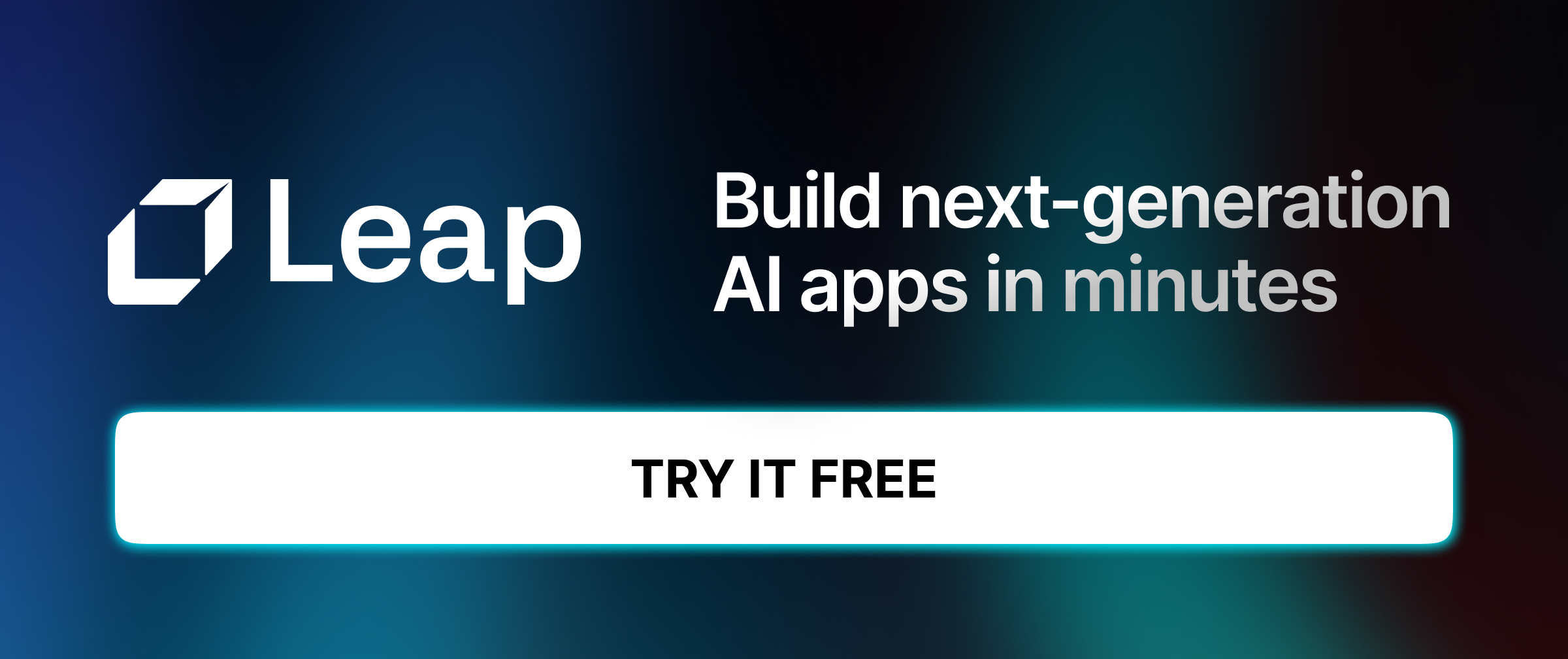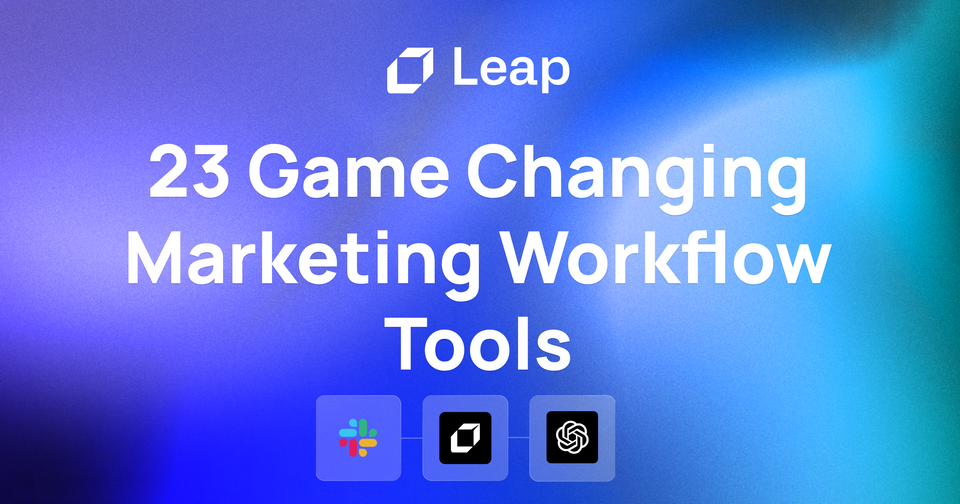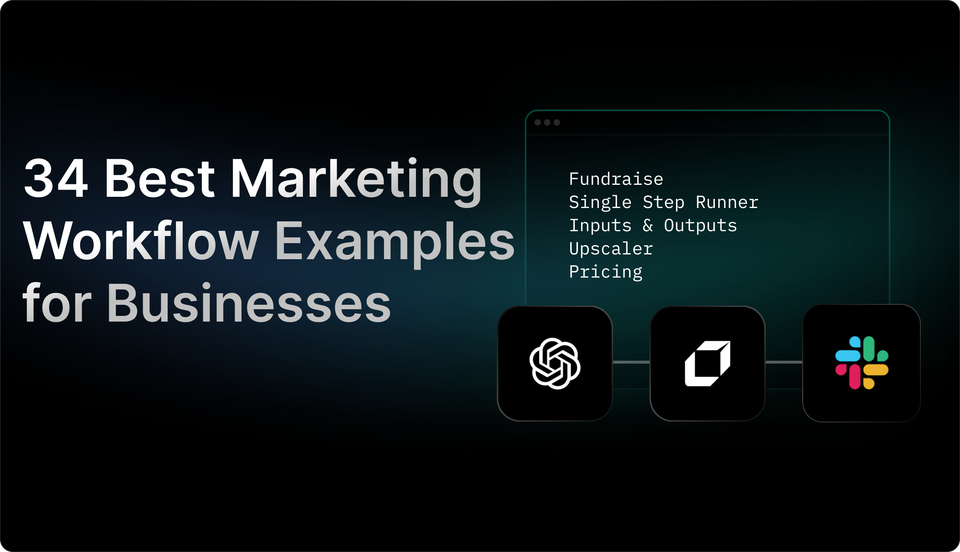41 Game Changing Digital Marketing Workflows To 10x Your Marketing
Optimize your strategy with seamless digital marketing workflows. Elevate efficiency and results with streamlined processes for online success.

In today's fast-paced digital landscape, where innovation and efficiency are paramount, the success of any business lies in mastering the art of digital marketing workflows. Like a well-orchestrated symphony, this marketing workflow seamlessly synchronizes various marketing tasks, ensuring a harmonious and productive operation.
From strategizing and planning to execution and analysis, digital marketing workflows are the backbone of every successful marketing campaign. In this blog, we will dive deeper into digital marketing workflows and how to use no-code tools to automate your workflows.

What Are Digital Marketing Workflows?

Digital marketing workflows are systematic processes that guide the execution of marketing tasks and activities in a digital environment. These workflows help businesses streamline their marketing efforts, ensuring that tasks are completed efficiently and effectively. By mapping out each step of the marketing process, businesses can achieve better coordination, collaboration, and productivity.
Why Are Digital Marketing Workflows Important?
Digital marketing workflows play a crucial role in maximizing the impact of marketing initiatives. They enable businesses to establish clear goals, define roles and responsibilities, and allocate resources effectively. By creating standardized processes, workflows ensure consistency in messaging, branding, and customer experience across different channels and touchpoints. These workflows promote transparency, allowing team members to track progress, identify bottlenecks, and make data-driven decisions.
How Do Digital Marketing Workflows Work?
Digital marketing workflows typically start with establishing objectives and target audiences. From there, they guide marketers through various stages, including planning, content creation, execution, analysis, and optimization. Each stage consists of specific tasks and milestones that need to be completed in a logical order. These workflows can be as simple as a linear progression of tasks or as complex as a branching sequence that adapts based on user behavior or campaign performance.
Benefits of Implementing Digital Marketing Workflows
1. Enhanced Efficiency
Workflows provide a roadmap for completing tasks, ensuring that everyone involved knows what needs to be done and when. This reduces confusion, minimizes delays, and improves overall productivity.
2. Consistency in Branding
By following predefined processes, businesses can maintain a consistent brand image and messaging throughout their marketing efforts. This consistency helps build trust and recognition among target audiences.
3. Improved Collaboration
Workflows facilitate collaboration among team members by clearly defining roles and responsibilities. This enables effective communication, reduces duplication of efforts, and fosters a sense of shared responsibility.
4. Better Resource Allocation
With workflows in place, businesses can allocate resources more effectively. By understanding the time and effort required for each task, teams can prioritize activities, optimize resource allocation, and ensure that nothing falls through the cracks.
5. Data-Driven Decision Making
Digital marketing workflows enable businesses to collect and analyze data at each stage of the process. This data-driven approach allows marketers to identify what is working and what needs improvement, leading to more informed decisions and better campaign optimization.
Digital marketing workflows offer a systematic approach to managing and executing marketing activities in the digital realm. By providing a clear framework for tasks and processes, these workflows enhance efficiency, consistency, collaboration, resource allocation, and decision making. By implementing digital marketing workflows, businesses can navigate the complex digital landscape with confidence, maximizing their marketing efforts and achieving their goals.

Related Reading
- Digital Marketing Workflow
- Content Marketing Workflows
- Email Marketing Workflows
- Ai For Small Business Marketing
41 Game Changing Digital Marketing Workflows To 10x Your Marketing

1. Content Marketing Workflow: Amplify Your Reach with Guest Blogging
Guest blogging is a powerful content marketing strategy that allows you to tap into new audiences and build your brand authority. Start by identifying relevant industry blogs and pitching your content ideas. Once accepted, create compelling and valuable guest posts that link back to your website. Promote these posts on your social media channels and email newsletter to maximize exposure.
2. Social Media Marketing Workflow: Leverage User-Generated Content
Harness the power of your audience by incorporating user-generated content into your social media strategy. Encourage customers to share their experiences with your brand through reviews, testimonials, or photos. Curate and share this content on your social media platforms, giving credit to the contributors. This not only increases engagement but also builds trust and authenticity around your brand.
3. Email Marketing Workflow: Personalize Your Communication
Personalization is key to effective email marketing. Start by segmenting your email list based on demographics, interests, or past behavior. Craft tailored messages that speak directly to each segment's needs and preferences. Use dynamic content and personalized subject lines to grab the reader's attention and improve click-through rates.
4. Influencer Marketing Workflow: Collaborate with Industry Experts
Identify key influencers in your industry who align with your brand values and target audience. Reach out to them with personalized pitches, highlighting the mutual benefits of collaboration. Provide influencers with exclusive content, product samples, or special offers to incentivize their participation. Track the performance of these collaborations to measure their impact on brand awareness and conversions.
5. Search Engine Optimization (SEO) Workflow: Optimize Your Website Structure
Start by conducting thorough keyword research to identify high-value keywords relevant to your business. Optimize your website's structure by creating a logical hierarchy of pages and organizing them into relevant categories. Create unique and informative content for each page, incorporating your target keywords. Improve your website's load time, mobile-friendliness, and user experience to enhance its SEO performance.
6. Pay-Per-Click (PPC) Advertising Workflow: Maximize Ad Performance with A/B Testing
Create multiple variations of your ad copy, headlines, and visuals to test different combinations. Run A/B tests to compare the performance of these variations and identify the most effective elements. Continuously optimize your ads based on the insights gained from these tests, focusing on improving click-through rates and conversion rates.
7. Video Marketing Workflow: Create Engaging Explainer Videos
Develop concise and engaging explainer videos that communicate your brand's value proposition. Use storytelling techniques to captivate your audience and keep them hooked. Ensure that the video is visually appealing, well-scripted, and professionally produced. Distribute the video on various platforms, including your website, social media channels, and video-sharing platforms like YouTube.
8. Conversion Rate Optimization (CRO) Workflow: Conduct User Testing
To improve your website's conversion rate, conduct user testing to gain insights into user behavior and pain points. Use tools like heatmaps, session recordings, and surveys to gather data on user interactions and preferences. Analyze this data to identify areas of improvement and implement changes that enhance the user experience and drive conversions.
9. Affiliate Marketing Workflow: Partner with Relevant Affiliates
Identify reputable affiliates in your industry who can promote your products or services to their audience. Create a clear affiliate program structure, detailing commission rates and promotional materials. Provide affiliates with exclusive discounts, customized landing pages, and marketing assets to support their promotion. Regularly track and optimize your affiliate marketing efforts to ensure maximum ROI.
10. Mobile Marketing Workflow: Optimize for Mobile Experience
With the rise in mobile device usage, it's crucial to optimize your marketing efforts for mobile users. Ensure that your website is mobile-friendly, with responsive design and fast loading times. Implement mobile-specific advertising strategies, such as mobile app install ads and click-to-call ads. Leverage location-based targeting to reach audiences in specific geographic areas.
11. Influencer Outreach Workflow: Develop Relationships with Influencers
Building strong relationships with influencers is essential for long-term success. Research and identify influencers who align with your brand values and target audience. Engage with them on social media, comment on their content, and share their posts. Reach out to them with personalized messages, expressing your admiration for their work and your interest in collaboration.
12. Social Listening Workflow: Monitor Brand Mentions
Monitor social media platforms, review sites, and online forums for brand mentions. Use social listening tools to track conversations, sentiment, and engagement around your brand. Respond promptly to customer feedback, whether positive or negative, to maintain a positive brand image. Identify trends and insights from these conversations to inform your marketing strategy.
13. Customer Journey Mapping Workflow: Understand the Customer's Path
Customer journey mapping is done to gain a deeper understanding of their interactions with your brand. Identify touchpoints and key decision-making stages. Analyze data from different channels to identify areas of improvement and opportunities for personalized marketing. Use the insights gained to create targeted campaigns that align with the customer's journey.
14. Chatbot Automation Workflow: Improve Customer Support and Engagement
Implement chatbots to automate customer support and enhance user experience. Use chatbots to answer frequently asked questions, provide recommendations, and even process transactions. Customize the chatbot's responses based on user behavior and preferences. Continuously optimize the chatbot's performance by analyzing user interactions and feedback.
15. Social Media Contest Workflow: Boost Engagement and Brand Awareness
Launch engaging social media contests to incentivize user participation and increase brand awareness. Define clear objectives, such as growing your social media following or collecting user-generated content. Develop enticing prizes and entry mechanisms that encourage sharing and virality. Promote the contest through your social media channels and collaborate with influencers to extend its reach.
16. Webinar Marketing Workflow: Educate and Convert Leads
Host informative webinars that address your target audience's pain points and provide valuable insights. Promote the webinar through email marketing, social media, and targeted advertising. Offer exclusive incentives, such as downloadable resources or limited-time discounts, to encourage registrations. Follow up with attendees after the webinar to nurture leads and drive conversions.
17. Remarketing Workflow: Re-engage Abandoned Visitors
Implement remarketing campaigns to re-engage visitors who have abandoned your website without converting. Use targeted ads to remind them of the products or services they showed interest in. Offer personalized discounts or incentives to entice them to return and complete their purchase. Continuously optimize your remarketing efforts based on user behavior and engagement data.
18. Influencer Takeover Workflow: Let Influencers Take the Lead
Allow influencers to take over your social media channels for a day or a specific campaign. This gives your audience a fresh perspective and introduces them to new content creators. Collaborate with influencers on the content creation process and provide guidelines to maintain brand consistency. Promote the influencer takeover through your social media channels to generate buzz and engagement.
19. Interactive Content Workflow: Enhance User Engagement
Develop interactive content, such as quizzes, polls, and interactive infographics, to increase user engagement. Encourage users to actively participate and share their results. Personalize the interactive experience based on the user's responses and provide tailored recommendations. Collect data from user interactions to gain insights into their preferences and behavior.
20. Marketing Automation Workflow: Nurture Leads with Drip Campaigns
Implement marketing automation tools to nurture leads and guide them through the sales funnel. Develop drip campaigns that deliver personalized content and offers at specific intervals. Use triggers based on user behavior, such as website visits or email opens, to send targeted messages. Continuously track and optimize the drip campaigns to improve conversion rates.
21. Influencer Outreach Workflow: Offer Exclusive Access or Experiences
Capture the attention of influencers by offering them exclusive access to your products, events, or experiences. Invite them to product launches, industry conferences, or behind-the-scenes tours. Provide them with personalized experiences and opportunities to create unique content. Leverage their influence and reach to amplify your brand's visibility and credibility.
22. Social Media Advertising Workflow: Target Lookalike Audiences
Utilize social media platforms' lookalike audience feature to reach new potential customers who have similar characteristics to your existing customer base. Identify your best-performing customer segments and create lookalike audiences based on their demographics, interests, and behaviors. Tailor your ad content to resonate with these audiences and drive conversions.
23. Interactive Email Workflow: Engage Subscribers with Interactive Elements
Differentiate your emails by incorporating interactive elements, such as GIFs, clickable images, or interactive surveys. Keep the email copy concise and visually appealing. Encourage subscribers to interact with the email by clicking on buttons or exploring interactive elements. Measure engagement metrics to understand the effectiveness of these interactive email campaigns.
24. Community Management Workflow: Build and Manage Online Communities
Engage with your audience by building and managing online communities, such as forums or social media groups. Foster a sense of belonging and encourage active participation through discussions, Q&A sessions, and exclusive content. Respond to user queries and feedback promptly to maintain a positive community experience. Leverage user-generated content within the community to create a sense of authenticity and trust.
25. Social Media Influencer Workflow: Collaborate with Micro-Influencers
Micro-influencers, with smaller but highly engaged followings, can be more cost-effective and impactful for certain niche markets. Identify micro-influencers who align with your brand values and target audience. Collaborate with them on content creation, giveaways, or reviews. Track the performance of these collaborations and measure the impact on brand awareness and conversions.
26. Data Analytics Workflow: Analyze and Optimize Marketing Efforts
Collect and analyze data from various marketing channels to gain insights into your customers' behaviors and preferences. Use analytics tools to track key performance indicators (KPIs) and set benchmarks for success. Identify areas of improvement and opportunities for optimization. Continuously monitor and refine your marketing efforts based on data-driven insights.
27. Gamification Workflow: Gamify User Experience for Increased Engagement
Incorporate gamification elements into your marketing campaigns to enhance user engagement and incentivize actions. Develop interactive games, challenges, or quizzes that reward users with points, badges, or discounts. Encourage competition among users and provide leaderboards to drive participation. Continuously optimize your gamification strategies based on user feedback and performance data.
28. Influencer Affiliate Programs Workflow: Combine Influencer and Affiliate Marketing
Create affiliate programs specifically designed for influencers, offering them a commission for driving sales or referrals. Provide influencers with customized affiliate links, discount codes, or tracking tools. Regularly communicate with influencers to share performance data and provide support. Monitor the performance of your influencer affiliate programs and optimize them for maximum ROI.
29. Podcast Marketing Workflow: Share Valuable Insights through Podcasts
Host a podcast series where you share valuable insights, industry trends, and interviews with experts. Promote the podcast through your website, social media channels, and podcast directories. Encourage listeners to subscribe, leave reviews, and share episodes. Leverage your podcast's content for blog posts, social media snippets, and email newsletters to maximize its reach and impact.
30. User-Generated Content Workflow: Encourage Customer Reviews and Testimonials
Leverage the power of customer reviews and testimonials to build trust and social proof. Implement strategies to encourage customers to leave reviews on platforms like Google My Business, Yelp, or industry-specific review sites. Showcase positive reviews and testimonials on your website and social media channels. Respond to both positive and negative feedback to demonstrate your commitment to customer satisfaction.
31. Influencer Webinars Workflow: Collaborate on Educational Webinars
Partner with influencers or industry experts to host webinars that educate your target audience. Identify topics that resonate with your audience and align with your brand's expertise. Collaborate with influencers on the content creation process, leveraging their unique insights and perspectives. Promote the webinars through your marketing channels and track their impact on lead generation and conversions.
32. Social Media Listening Workflow: Identify Trends and Insights
Utilize social media listening tools to monitor conversations, trends, and sentiment around your industry. Identify emerging trends and topics that are relevant to your target audience. Use these insights to inform your content strategy, create timely and engaging posts, and join relevant conversations. Leverage social listening data to better understand your audience and tailor your marketing efforts.
33. Customer Retention Workflow: Implement Loyalty Programs
Develop loyalty programs to reward and retain your existing customers. Offer exclusive discounts, early access to new products, or personalized recommendations based on their purchase history. Collect feedback from loyal customers and use it to improve your products or services. Continuously communicate with your loyal customers to maintain their engagement and loyalty.
34. Web Personalization Workflow: Deliver Tailored Experiences
Implement web personalization strategies to deliver tailored experiences to your website visitors. Utilize user data, such as previous interactions or demographics, to customize content, recommendations, or offers. Optimize landing pages and product pages based on visitor segments to increase conversions. Continuously monitor user behavior and adjust personalization strategies to maximize engagement and conversions.
35. Influencer Event Takeover Workflow: Let Influencers Host Events
Invite influencers to host or co-host exclusive events, such as webinars, workshops, or Q&A sessions. Leverage their expertise and audience engagement to create valuable experiences for your target audience. Promote these events through your marketing channels and encourage audience participation. Collaborate with influencers on event content and follow up with attendees to nurture leads.
36. Growth Hacking Workflow: Identify and Exploit Growth Opportunities
Adopt a growth hacking mindset to identify unconventional and cost-effective marketing strategies. Experiment with different tactics, such as referral programs, viral campaigns, or partnerships. Continuously measure and analyze the impact of these strategies on user acquisition, engagement, and conversions. Iterate and optimize your growth hacking efforts based on the insights gained.
37. Customer Advocacy Workflow: Empower Brand Ambassadors
Identify and nurture brand ambassadors among your loyal customers. Encourage them to share their positive experiences with your brand on social media, review sites, or through word-of-mouth. Provide them with exclusive perks, discounts, or early access to new products. Amplify their content and engage with them to strengthen the brand-customer relationship.
38. Native Advertising Workflow: Blend In with Relevant Content
Develop native advertising campaigns that seamlessly blend your brand's content with relevant publishers' platforms. Create valuable and informative content that aligns with the publisher's audience and context. Drive traffic to your website or landing pages through native ads that are non-disruptive and provide value to the target audience.
39. Public Relations Workflow: Build Relationships with Journalists
Establish relationships with journalists, bloggers, and industry influencers to secure media coverage for your brand. Research journalists who cover your industry and their preferred communication methods. Reach out to them with personalized pitches and exclusive news or insights. Provide them with relevant resources, expert opinions, or access to exclusive events to enhance their coverage.
40. Chatbot Sales Workflow: Automate Sales Conversations
Deploy chatbots to automate sales conversations and guide potential customers through the purchase process. Use chatbots to answer product-related queries, provide personalized recommendations, and facilitate transactions. Integrate the chatbot with your CRM system to capture leads and track their interactions. Continuously optimize the chatbot's sales workflow based on user feedback and conversion data
41. Partnership Marketing Workflow: Collaborate for Mutual Benefits
Identify strategic partners who share a similar target audience but offer complementary products or services. Collaborate on joint marketing campaigns, cross-promotions, or co-branded content. Leverage each other's networks and customer bases to increase brand exposure and drive conversions. Continuously measure the impact of these partnerships and explore new opportunities for collaboration.
Related Reading
- Content Marketing Workflow
- Digital Marketing Agency Workflow
- Marketing Automation Workflows
- Marketing Workflow Management
- Marketing Workflow Examples
The Importance of Automating Your Digital Marketing Workflows

Streamlining and automating digital marketing workflows has become crucial for businesses in today's fast-paced and technologically advanced world. By implementing automation tools and processes, companies can significantly improve their efficiency, productivity, and overall marketing performance. Let's explore the importance of automating digital marketing workflows in more detail.
1. Enhanced Efficiency and Time Savings
Automating digital marketing workflows allows businesses to eliminate manual and repetitive tasks, enabling their marketing teams to focus on more strategic and creative activities. By automating tasks such as lead nurturing, email campaigns, content distribution, and social media scheduling, companies can free up valuable time and resources. This increased efficiency enables marketers to allocate their time and energy to other critical aspects of their job, such as analyzing data, refining strategies, and optimizing campaigns for better results.
2. Consistency in Execution
In the world of digital marketing, consistency is crucial for building brand reputation and customer loyalty. Automated workflows ensure that marketing activities follow a consistent and standardized process, minimizing the risk of human error and ensuring that campaigns are executed as planned. From creating landing pages to sending personalized emails, automation tools can ensure that every step of the marketing process is executed consistently, resulting in a cohesive and seamless customer experience.
3. Personalization and Targeting
Effective digital marketing relies heavily on personalization and targeting. By automating workflows, businesses can leverage customer data to deliver highly personalized and targeted content to their audience at the right time and through the right channels. Automation tools can collect and analyze customer data, segment audiences based on demographics, interests, and behaviors, and deliver tailored messages accordingly. This level of personalization not only increases customer engagement but also improves conversion rates and ROI.
4. Improved Lead Nurturing and Conversion
Lead nurturing plays a vital role in converting prospects into paying customers. Automating lead nurturing workflows enables businesses to deliver timely and relevant content to leads based on their stage in the sales funnel. By tracking and analyzing customer behavior, automation tools can trigger automated emails, personalized recommendations, and targeted ads, ensuring that leads receive the right information at the right time. This automated lead nurturing process improves the chances of converting leads into customers and reduces the likelihood of leads slipping through the cracks.
5. Data-Driven Decision Making
Automation tools generate a wealth of data and insights that can inform marketing strategies and decision-making. By automating digital marketing workflows, businesses can collect data on campaign performance, customer interactions, and conversion rates. This data can be analyzed to identify trends, understand customer behavior, and optimize marketing efforts. With access to real-time data and analytics, marketers can make informed decisions, adjust strategies on the fly, and continually improve their digital marketing performance.
Automating digital marketing workflows has become imperative for businesses seeking to thrive in the digital landscape. The benefits of automation include enhanced efficiency, time savings, consistency in execution, personalization, improved lead nurturing and conversion, and data-driven decision-making. By harnessing the power of automation tools, companies can streamline their marketing processes, optimize their campaigns, and achieve better results in an increasingly competitive market.
The Benefits of Using No-Code Tools for Your Digital Marketing Workflows

In today's digital age, businesses rely heavily on effective digital marketing strategies to promote their products and services. To streamline and optimize these strategies, many marketers are turning to no-code tools for their digital marketing workflows. No-code tools have gained popularity due to their ease of use, cost-effectiveness, and ability to enhance productivity. We will explore the benefits of using no-code tools for your digital marketing workflows.
1. Streamlined Processes
Implementing no-code tools in your digital marketing workflows can lead to streamlined processes. These tools offer pre-built templates and drag-and-drop functionality, eliminating the need for manual coding. By simplifying complex tasks, like building landing pages or creating email campaigns, no-code tools allow marketers to focus on strategic planning and creative aspects of their campaigns. This increased efficiency can save time and resources, enabling marketers to deliver campaigns quicker and more effectively.
2. Increased Collaboration
Collaboration is essential for successful digital marketing workflows. No-code tools offer collaborative features that allow teams to work together seamlessly. These tools provide real-time editing, commenting, and sharing capabilities, making it easier for team members to provide input, review, and approve marketing materials. By fostering collaboration, no-code tools enhance communication and enable teams to work more efficiently towards shared goals.
3. Cost-Effectiveness
Traditional coding can be expensive, requiring specialized skills and resources. No-code tools offer a cost-effective alternative by eliminating the need for coding expertise. Marketers can create and modify digital assets without the help of developers, reducing overhead costs. No-code tools often offer flexible pricing models, allowing businesses to scale their usage as needed. By leveraging no-code tools, businesses can achieve cost savings while still maintaining high-quality digital marketing campaigns.
4. Agility and Adaptability
Digital marketing landscapes are constantly evolving, requiring marketers to adapt quickly. No-code tools enable marketers to respond to changes rapidly by empowering them to make updates and modifications without relying on developers. With the ability to iterate and test campaigns in real-time, marketers can optimize their strategies and stay ahead of the competition. No-code tools provide the flexibility and agility needed to experiment, analyze data, and make informed decisions to ensure continuous improvement.
5. Accessibility
No-code tools are designed to be user-friendly, making them accessible to marketers of all skill levels. These tools typically offer intuitive interfaces, tutorials, and support resources, allowing marketers to quickly learn and utilize their capabilities. With no coding knowledge required, marketers can take full control of their digital marketing workflows, empowering them to execute their ideas and strategies independently. This accessibility reduces reliance on external resources and empowers marketers to implement their vision efficiently.
No-code tools offer numerous benefits for digital marketing workflows. By streamlining processes, increasing collaboration, providing cost-effectiveness, enabling agility and adaptability, and ensuring accessibility, these tools empower marketers to take control of their campaigns and deliver impactful results. Incorporating no-code tools into your digital marketing workflows can revolutionize your marketing efforts, allowing you to focus on what truly matters - connecting with your audience and achieving your business goals.
Create Game Changing Automations Today With Leap’s AI Workflows
With the rapid advancement of AI technology, automating your digital marketing workflows has become easier than ever. Leap is here to revolutionize the way you work by harnessing the power of AI. By partnering with industry leaders such as Zapier and Vercel, Leap offers an extensive range of AI automations that can take your digital marketing efforts to new heights.
No-Code Custom AI Automations
One of the standout features of Leap is its ability to create custom AI automations without the need for coding. Whether you want to summarize documents, translate voice recordings, transcribe calls, generate AI avatars and assets, or automate SEO tasks, Leap Workflows has got you covered. The no-code interface ensures that you can easily set up and modify automations, even if you don't have a background in coding.
Connect Your Favorite Tools with AI Models
Leap enables you to seamlessly integrate your favorite tools with best-in-class AI text, image, and audio models. This means you can supercharge your existing tools with the power of AI to achieve even better results. Whether you want to leverage OpenAI's cutting-edge language models or Microsoft's speech recognition capabilities, Leap has you covered. The possibilities for automation are truly endless with Leap Workflows.
Endless Opportunities for Automation
When it comes to digital marketing workflows, the opportunities for automation are truly endless with Leap. From streamlining content creation and optimization to enhancing customer support and lead generation, Leap can handle it all. You can automate tasks such as analyzing customer feedback, generating personalized product recommendations, monitoring social media engagements, and much more. With Leap, you can free up valuable time and resources that can be better utilized for strategic planning and decision-making.
Try Leap Workflows for Free Today
Ready to supercharge your digital marketing workflows with the power of AI? Try Leap's Workflows tool for free today. Experience the ease and efficiency of creating custom AI automations without the need for coding. Connect your favorite tools with best-in-class AI models and unlock endless opportunities for automation. Say goodbye to manual, repetitive tasks and hello to a more productive and innovative way of working. Get started with Leap Workflows today and revolutionize your digital marketing efforts.




